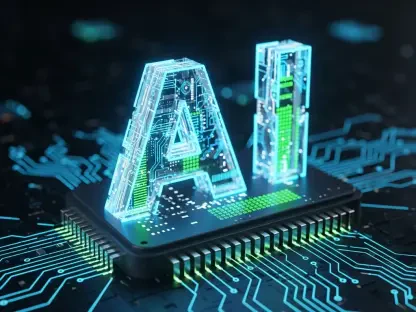The Growing Role of AI in Software Development
The software development industry stands at a pivotal moment, with artificial intelligence (AI) tools reshaping every facet of the craft, from ideation to deployment, and as developers face mounting pressure to deliver faster and more innovative solutions, AI has emerged as a transformative force. Promising to streamline workflows and boost productivity, AI brings a wave of enthusiasm, yet beneath it lies a pressing concern: could these very tools introduce unforeseen risks to the safety and integrity of software development? This question drives a deeper exploration into AI’s expanding footprint across the sector.
AI’s integration into the software development lifecycle has accelerated dramatically, evolving from rudimentary code completion features to advanced assistants capable of generating complex modules. Tools like GitHub Copilot and ChatGPT have become indispensable for many developers, automating repetitive tasks and offering real-time suggestions. Major tech companies and startups alike are driving this adoption, fueled by the need for efficiency and a competitive edge in a fast-paced market. The scope of AI’s influence now spans coding, debugging, automated testing, and even deployment strategies, fundamentally altering how software is built.
Beyond mere automation, AI’s significance lies in its ability to handle large-scale data analysis and predict potential issues before they arise. Its presence is felt in agile methodologies, where rapid prototyping and iterative feedback loops are enhanced by machine learning algorithms. However, this rapid embedding of AI into critical processes raises questions about reliability and oversight, setting the stage for a nuanced examination of its impact on the industry.
Benefits and Trends of AI in Software Development
Key Trends Shaping AI Adoption
The surge of AI in software development is underpinned by several defining trends that reflect both technological advancements and market dynamics. Emerging technologies, such as generative AI models trained on vast code repositories, are enabling unprecedented levels of automation in writing and optimizing code. This shift is not merely a convenience but a response to competitive pressures, where companies race to shorten time-to-market and outpace rivals through innovation.
Another notable trend is the change in developer behavior, as professionals increasingly rely on AI for tasks once done manually. This reliance fosters a culture of collaboration between human expertise and machine efficiency, opening doors to faster prototyping and reduced workloads. Additionally, the democratization of AI tools through accessible platforms allows even smaller teams to leverage cutting-edge capabilities, leveling the playing field and spurring creativity across the board.
Opportunities abound as AI continues to redefine traditional workflows. The ability to quickly generate functional prototypes has empowered developers to experiment with bold ideas without the burden of extensive manual effort. As these trends gain momentum, they highlight a broader movement toward integrating AI as a core component of development strategies, pushing the industry into uncharted territory.
Performance Metrics and Future Outlook
Data underscores the profound impact AI is having on software development efficiency. Recent studies indicate that over 60% of developers now use AI tools in some capacity, with many reporting productivity gains of up to 40% on repetitive tasks. Adoption rates are climbing steadily, particularly among enterprises aiming to scale operations without proportional increases in headcount, signaling a robust trend that shows no signs of slowing.
Looking ahead, growth projections suggest that the market for AI-driven development tools will expand significantly from this year through 2027, driven by continuous improvements in natural language processing and machine learning. These advancements promise to make AI assistants even more intuitive, capable of understanding complex project requirements with minimal input. Such forecasts point to a future where AI could become as ubiquitous as integrated development environments in daily workflows.
The long-term outlook envisions AI not just as a tool but as a fundamental driver of software development practices. As algorithms grow smarter, they may take on greater roles in decision-making, from architecture design to risk assessment. This potential, while exciting, necessitates a careful balance to ensure that human judgment remains central to critical processes, shaping how the industry evolves in the coming years.
Critical Risks and Challenges of AI Integration
The integration of AI into software development, while promising, is fraught with significant risks that demand attention. One primary concern is the quality of AI-generated code, which often lacks contextual understanding of specific project needs, leading to buggy or inefficient outputs. Security vulnerabilities also loom large, as AI tools may inadvertently introduce flaws like SQL injections or expose sensitive data, posing threats to entire systems.
Beyond technical issues, intellectual property disputes present a legal minefield, with ambiguity around ownership of AI-generated code sparking lawsuits and compliance challenges. Integration hurdles further complicate matters, as AI outputs may clash with existing systems, causing delays or errors in complex environments. Additionally, hidden costs—such as API fees, model retraining, and compliance audits—can erode the perceived financial benefits of AI adoption, catching many organizations off guard.
Other challenges include bias in AI outputs, which can perpetuate unfair practices, and the risk of skill degradation among developers overly reliant on automation. Mitigation strategies are essential to address these concerns, including robust human oversight, rigorous testing protocols, and pilot projects to assess risks before full-scale implementation. By adopting such measures, the industry can strive to harness AI’s potential while safeguarding against its pitfalls.
Regulatory and Ethical Considerations
Navigating the legal and ethical landscape of AI in software development is no small task, as compliance with global standards like GDPR and HIPAA becomes increasingly critical. These regulations demand stringent data protection measures, especially when AI tools process sensitive information, creating a complex web of obligations for organizations. Failure to adhere to these standards can result in hefty penalties and reputational damage, amplifying the stakes.
Ethical concerns also weigh heavily, particularly around bias in AI models that may lead to discriminatory outcomes in software applications. Intellectual property and licensing ambiguities add another layer of difficulty, with real-world cases—such as lawsuits over unattributed AI-generated code—highlighting the need for clearer guidelines. These issues underscore the importance of establishing governance frameworks to ensure fair and secure AI usage across diverse contexts.
The role of governance cannot be overstated, as it provides a foundation for addressing both legal and ethical dilemmas. Developing policies that prioritize transparency, accountability, and regular audits can help mitigate risks while fostering trust among stakeholders. As the regulatory environment continues to evolve, staying ahead of these considerations will be paramount for responsible AI adoption in the industry.
The Future of AI in Software Development
Peering into the horizon, the trajectory of AI in software development appears poised for groundbreaking advancements that could redefine the field. Emerging technologies, such as more sophisticated generative models, are expected to enhance AI’s ability to tackle intricate coding challenges with greater precision. These innovations may pave the way for tools that not only assist but also anticipate developer needs, streamlining workflows further.
Potential disruptors, including shifts in regulatory landscapes and economic conditions, will likely influence how AI tools are developed and deployed globally. Developer needs are also evolving, with a growing demand for customizable AI solutions tailored to specific industries or project types. These dynamics suggest a future where adaptability and specialization become key differentiators in the crowded AI tool market.
Balancing innovation with risk management will remain a central theme as AI’s role expands. Global trends, such as increasing scrutiny over data privacy and ethical implications, will shape adoption strategies, pushing organizations to prioritize safety alongside progress. Navigating this delicate equilibrium will be crucial for ensuring that AI continues to drive value without compromising the integrity of software development processes.
Balancing Innovation with Safety
Reflecting on the insights gathered, it becomes evident that AI’s dual nature as both an enabler and a liability has sparked intense debate within the software development community. The exploration revealed how its capacity to revolutionize efficiency is often tempered by substantial risks that demand vigilance. Each facet, from benefits to regulatory challenges, paints a picture of an industry at a crossroads, weighing transformative potential against critical vulnerabilities.
Moving forward, actionable steps emerge as vital for harnessing AI’s strengths while addressing its shortcomings. Organizations are encouraged to establish robust governance frameworks, ensuring that human oversight remains integral to every stage of AI integration. Prioritizing continuous evaluation and investing in developer training also stand out as essential measures to maintain skill levels and adapt to evolving tools.
Ultimately, the journey underscores a pressing need for collaboration across stakeholders to refine AI’s application in software development. By fostering dialogue on best practices and advocating for clearer regulatory guidelines, the industry can build a safer, more innovative future. These steps promise to guide the sector toward sustainable growth, ensuring that AI’s promise is realized without sacrificing the foundational safety that underpins reliable software solutions.








